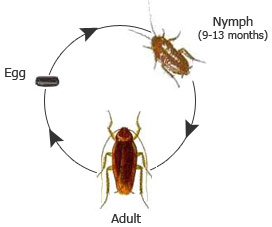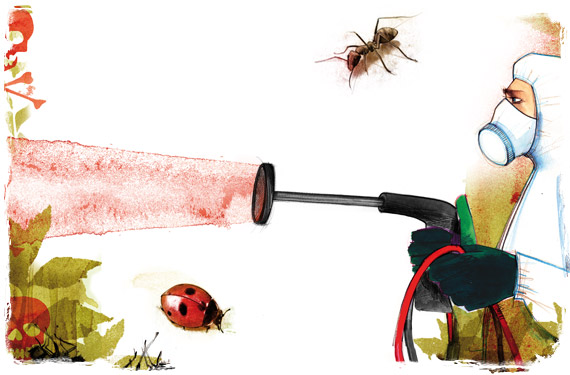CHAPTER 6- VECTOR CONTROL
What is vectors and pests actually? Well, today I will define the meaning of vector and pests.
Vectors is animal or insects that bring diseases to human. Pests is a destructive insect or other animal that attacks crops, food and livestock.

(sources from http://bad2thebugs.com/?page_id=15)
Vector is also known as a vehicle that brings agent to the host based from the epidemiology triangle. Not all vectors is a pests and not all pests is a vector.
There are some example of vectors which are rodents, cockroach, mosquitoes, flies, fleas and ticks.

(source from https://onlinecourses.science.psu.edu/stat507/node/25)
TYPES OF VECTORS AND PESTS:
Rodents- Commonsal rodent (live at where humans exists) which brings rat-bite fever, it's urine is responsible for the spread of leptospirosis. The one of the most historically dangerous rat-borne diseases is the bubonic plague, also called “Black Plague”.
Roof rats (rattus rattus)

(source from http://www.chandleraz.gov/default.aspx?pageid=436)
House mice (Mus Muskulus)

(source from http://www.economyexterminators.com/house-mice)
Norway rats (Rattus Norvegicas)

(source from https://www.wittpm.com/bug-guide/profile/norway-rats)
ARTHROPODS:
Mosquitoes- Is an insects that bites the skin of people and animals and sucks their blood. It can spread its diseases from it's proboscis (sharp beak on it's mouth) and salivary gland. It carry dangerous diseases such as dengue, malaria, yellow fever, chikungunya and filariasis. Its only active during dawn and dusk only.
(source from http://www.enchantedlearning.com/subjects/insects/mosquito/lifecycle.shtml)
Flies- House flies are recognised as carriers of easily communicable diseases. It also collect pathogens on their legs and mouths and carry diseases on their legs and the small hairs that cover their bodies.

(source from http://animals.howstuffworks.com/insects/housefly4.htm)
House flies are strongly suspected of transmitting at least 65 diseases to humans, including typhoid fever, dysentery, cholera, poliomyelitis, yaws, anthrax, tularemia, leprosy and tuberculosis. Flies regurgitate and excrete wherever they come to rest and thereby mechanically transmit disease organisms.
It usually appear at dirty place such as trash can, market, slaughter house, food factory processes and animal barns.
Cockroach- They are common and hardy insects, and can tolerate a wide range of environments from Arctic cold to tropical heat. Its usually live at dark place or slit places such as in the drain at the bathroom or in the cupboard. It usually active during night time.

(source from http://www.pestcontrol.ae/cockroaches-life-cycle)
It is believed that the cockroach may be a reservoir for a range of bacteria including salmonella, staphylococcus and streptococcus. The cockroach can also harbour viruses such as the polio virus.
Types of cockroaches:

A) German cockroach
B) American cockroach
C) Australian cockroach
D&E) Oriental cockroach
(source from https://en.wikipedia.org/wiki/Cockroach)
4 Pest control:

(source from http://www.amalpest.com.au/LearningCentre/PestControlStrategies)
Biological control- is a method of controlling pests such as insects, mites, weeds and plant diseases using other organisms. It relies on predation, parasitism, herbivory, or other natural mechanisms, but typically also involves an active human management role.

(source from https://en.wikipedia.org/wiki/Biological_pest_control)
Cultural- it is the oldest methods that have been used to manage pest populations and they are preventative rather than curative they are dependent on long-range planning.

(source from http://horticulture.tekura.school.nz/plant-management/plant-management-3/ht1103-plant-management-3-study-plan/integrated-pest-management-ipm/)
Physical- is a method of getting rid of insects and small rodents by removing, attacking, or setting up barriers that will prevent further destruction of one's plants.

(source from http://2015.igem.org/Team:Lethbridge/Practices_Current)

(source from http://www.canna-uk.com/how_control_pests_and_diseases_biological_vs_chemical)
Chemical- it is often used to control diseases, pests or weeds. Chemical control is based on substances that are toxic (poisonous) to the pests involved. When chemical pesticides are applied to protect plants from pests, diseases or overgrowth by weeds, we speak of plant protection products. It is of course important that the plant that needs protection does not itself suffer from the toxic effects of the protection products.

(source from http://www.padminipestcontrol.com/)
All my points is not mine, please refer it to link below:
http://www.merriam-webster.com/dictionary/pest
http://www.orkin.com/rodents/rats/rat-borne-diseases/
https://en.wikipedia.org/wiki/Mosquito-borne_disease
http://www.orkin.com/flies/house-fly/house-fly-and-disease/
http://ento.psu.edu/extension/factsheets/house-flies
https://www.betterhealth.vic.gov.au/health/healthyliving/
https://en.wikipedia.org/wiki/Biological_pest_control
http://eap.mcgill.ca/publications/eap58.htm
https://en.wikipedia.org/wiki/Physical_pest_control
https://en.wikipedia.org/wiki/Pest_control
No comments:
Post a Comment